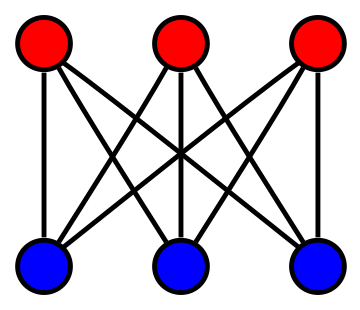Are there examples of d-regular graphs (i.e. graphs where every node has exactly d adjacent nodes) which are not the 1-skeleton of a simple convex polytope?
UPDATE:
New version of the question: is there an example of a d-dimensional "simple" poset, i.e. a collection of k-dimensional "faces" with $k=0, 1, \dots, d$ equipped with partial ordering such that its 1-dimensional skeleton is a d-regular graph, which is not the face lattice of a convex polytope? (Obviously the partial order is to be interpreted as $X < Y$ if $X$ is contained in the boundary of $Y$).
It seems to be that the graph of the previous answer ($K_{3,3}$) cannot be interpreted as the 1-skeleton of a 3-dimensional simple poset.
NEW UPDATE:
By convex polytope I mean the intersection of several half-spaces given by linear inequalities. The boundaries of a convex polytope are themselves convex polytopes, the full collection of these boundaries of any co-dimension define the face lattice of the polytope.
We can represent the combinatorics of the face lattice of a d-dimensional convex polytope by giving the collection of its facets $F=\{X_1, \dots, X_F\}$ and vertices $V=(v_1, \dots, v_n)$ and representing each vertex as the intersection of at least $d$ facets, e.g. we can write $v_j = (X_{j_1}, \dots, X_{j_d})$ to say that vertex $v$ lies in the intersection of faces $X_{j_1}, \dots, X_{j_d}$. In particular if the polytope is simple, every vertex will be presented as the intersection of $precisely$ $d$ facets. I am only interested in this case, so let me assume that the set $V$ is always a set of $d$-tuples of elements in $F$.
From this data, we can read all the face lattice structure: two facets $X_a$ and $X_b$ intersect in the polytope if and only if there is at least one vertex containing both. Each facet $X_a$ is itself a polytope whose combinatorial data can be presented in the same way, i.e. by listing all the facets $X_b$ intersecting with $X_a$ and all the vertices lying on $X_a$. Clearly we can iterate down to any dimension.
Now suppose you are given a set of data $(F,V)$, and you are asked to understand wether there exists a simple polytope whose face lattice is given by $(F,V)$. You can do a number of combinatorical and topological checks on $(F,V)$: you can compute the euler characteristic and check that is 1, or you can compute all the homological groups of $(F,V)$ and see that they are compatible with those of a convex set. Admittedly, I do not know what is the set of $all$ checks one can do before trying to find an actual convex realisation of the polytope... My question is: is there a counterexample of a set of data $(F,V)$ that meets all these criteria, but is known not to arise from a simple convex polytope?
SUMMARY OF PREVIOUS ANSWERS:
David Speyer:
The 0-faces are the vertices (1,2,3,-1,-2,-3). Higher dimensional facets are represented by giving the vertices lying on them. The 3-faces are the five element sets (1,2,−2,3,−3), (−1,2,−2,3,−3), (1,−1,2,3,−3), and (1,−1,−2,3,−3). The 2-faces are (2,−2,3,−3), (1,−1,3,−3) and the eight three-element sets of the form (±1,±2,±3). The 1-faces are the 12 pairs (i,j) with i≠−j.
In this answer the 3-face $(1,2,-2,3,-3)$ it's not a simple polytope, since the vertex 1 is adjacent to more than 3 vertices.
M. Winter:
1) In the hemicube there are three faces $F=\{X_1,X_2,X_3\}$ and each vertex is presented as their intersection $v = (X_1,X_2,X_3)$. So $(F,V)$ cannot arise from a 3-dimensional convex polytope which must have at least 4 vertices. 2) The hemidodecagon is trickier, we have 6 facets $F=\{X_1, \dots, X_6\}$ and 10 vertices $V=\{(X_1,X_2,X_4), (X_1,X_2,X_6), (X_1,X_3,X_4), (X_1,X_3,X_5), (X_1,X_5,X_6), (X_2,X_3,X_5), (X_2,X_3,X_6), (X_2,X_4,X_5), (X_3,X_4,X_6), (X_4,X_5,X_6)\}$. The putative polytope should be 3-dimensional, but from $(F,V)$ we can read an obstruction: start from vertex 1 and orient the facets incident there as $(X_1 \to X_2 \to X_4)$, jump to the vertex 2 and to be consistent with the previous orientation now the faces have to be oriented as $(X_1 \to X_6 \to X_2)$, but is impossible to find an orientation at each vertex consistent with this jump rule.

